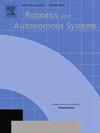改进的 ACO 算法与改进的 Q-Learning 算法融合,用于搜索和救援机器人的贝塞尔曲线全局路径规划
IF 4.3
2区 计算机科学
Q1 AUTOMATION & CONTROL SYSTEMS
引用次数: 0
摘要
针对传统蚁群算法和强化学习算法存在的搜索效率低、生成的路径不够平滑、容易陷入局部最优等问题,本文设计了一种改进的蚁群优化算法与改进的Q-Learning算法(IAC-IQL)融合的蚁群算法,用于搜救机器人的贝塞尔曲线全局路径规划。首先,改进了蚁群算法中的启发式函数模型,引入了精英蚂蚁搜索策略和自适应信息素波动因子策略,并借助改进的蚁群算法在实现运动环境中搜索初始路径,构建初始化信息素矩阵。其次,利用改进蚁群算法中信息素矩阵与 QL 算法中 Q 矩阵的相似性,将改进蚁群算法与 QL 算法进行融合。设计的启发式学习评估模型可动态调整学习因子,为搜索路径提供指导。此外,还引入了动态自适应贪婪策略,以平衡机器人在环境中的探索和利用。最后,利用三阶贝塞尔曲线对路径进行平滑处理,以消除转向角过大的问题。通过在 Pycharm 平台上进行的三组对比仿真实验,验证了 IAC-IQL 算法的有效性、优越性和实用性。实验结果表明,IAC-IQL 算法集成了蚁群算法的强大搜索能力和 QL 算法的自学习特性。采用改进的 IAC-IQL 算法的合成孔径雷达机器人在网格模拟环境和图像采样模拟环境中的迭代搜索效率明显提高。全局路径优化指标效率高,路径更平滑。本文章由计算机程序翻译,如有差异,请以英文原文为准。
Improved ACO algorithm fused with improved Q-Learning algorithm for Bessel curve global path planning of search and rescue robots
Addressing issues with traditional ant colony and reinforcement learning algorithms, such as low search efficiency and the tendency to produce insufficiently smooth paths that easily fall into local optima, this paper designs an improved ant colony optimization algorithm fusion with improved Q-Learning (IAC-IQL) algorithm for Bessel curve global path planning of search and rescue (SAR) robots. First, the heuristic function model in the ant colony algorithm is improved, the elite ant search strategy and the adaptive pheromone volatility factor strategy are introduced, and the initial path is searched in realize the motion environment with the help of the improved ant colony algorithm, and the initialized pheromone matrix is constructed. Second, the improved ant colony algorithm and Q-Learning (QL) algorithm are fused by utilizing the similarity between the pheromone matrix in the improved ant colony algorithm and the Q-matrix in the QL algorithm. A heuristic learning evaluation model is designed to dynamically adjust the learning factor and provide guidance for the search path. Additionally, a dynamic adaptive greedy strategy is introduced to balance the exploration and exploitation of the robot in the environment. Finally, the paths are smoothed using third-order Bessel curves to eliminate the problem of excessive steering angles. Through three sets of comparative simulation experiments conducted in Pycharm platform, the effectiveness, superiority, and practicality of the IAC-IQL algorithm were verified. The experimental results demonstrated that the IAC-IQL algorithm integrates the strong search capability of ant colony algorithm and the self-learning characteristics of QL algorithm. SAR robots equipped with the improved IAC-IQL algorithm exhibit significantly enhanced iterative search efficiency in grid simulation environment and image sampling simulation environment. The global path optimization indicators demonstrate high efficiency, and the paths are smoother.
求助全文
通过发布文献求助,成功后即可免费获取论文全文。
去求助
来源期刊

Robotics and Autonomous Systems
工程技术-机器人学
CiteScore
9.00
自引率
7.00%
发文量
164
审稿时长
4.5 months
期刊介绍:
Robotics and Autonomous Systems will carry articles describing fundamental developments in the field of robotics, with special emphasis on autonomous systems. An important goal of this journal is to extend the state of the art in both symbolic and sensory based robot control and learning in the context of autonomous systems.
Robotics and Autonomous Systems will carry articles on the theoretical, computational and experimental aspects of autonomous systems, or modules of such systems.
 求助内容:
求助内容: 应助结果提醒方式:
应助结果提醒方式:


